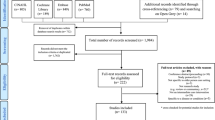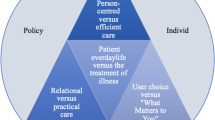Abstract
Background
Although there is growing utilisation of intermediate care to improve the health and well-being of older adults with complex care needs, there is no international agreement on how it is defined, limiting comparability between studies and reducing the ability to scale effective interventions.
Aim
To identify and define the characteristics of intermediate care models.
Methods
A scoping review, a modified two-round electronic Delphi study involving 27 multi-professional experts from 13 countries, and a virtual consensus meeting were conducted.
Results
Sixty-six records were included in the scoping review, which identified four main themes: transitions, components, benefits and interchangeability. These formed the basis of the first round of the Delphi survey. After Round 2, 16 statements were agreed, refined and collapsed further. Consensus was established for 10 statements addressing the definitions, purpose, target populations, approach to care and organisation of intermediate care models.
Discussion
There was agreement that intermediate care represents time-limited services which ensure continuity and quality of care, promote recovery, restore independence and confidence at the interface between home and acute services, with transitional care representing a subset of intermediate care. Models are best delivered by an interdisciplinary team within an integrated health and social care system where a single contact point optimises service access, communication and coordination.
Conclusions
This study identified key defining features of intermediate care to improve understanding and to support comparisons between models and studies evaluating them. More research is required to develop operational definitions for use in different healthcare systems.



Similar content being viewed by others
References
Mansukhani RP, Bridgeman MB, Candelario D et al (2015) Exploring transitional care: evidence-based strategies for improving provider communication and reducing readmissions. P&T 40:690–694
Kripalani S, LeFevre F, Phillips CO et al (2007) Deficits in communication and information transfer between hospital-based and primary care physicians: implications for patient safety and continuity of care. JAMA 297:831–841
Lima M, Magalhaes AMM, Oelke ND et al (2018) Care transition strategies in Latin American countries: an integrative review. Rev Gaucha Enferm 39:e20180119
Coffey A, Leahy-Warren P, Savage E et al (2019) Interventions to promote early discharge and avoid inappropriate hospital (re)admission: a systematic review. Int J Environ Res Public Health 16:E2457
Forster AJ, Clark HD, Menard A et al (2004) Adverse events among medical patients after discharge from hospital. CMAJ 170:345–349
Baillie L, Gallini A, Corser R et al (2014) Care transitions for frail, older people from acute hospital wards within an integrated healthcare system in England: a qualitative case study. Int J Integr Care 14:e009
Allen J, Hutchinson AM, Brown R et al (2018) User experience and care for older people transitioning from hospital to home: patients' and carers' perspectives. Health Expect 21:518–527
Peel NM, Hubbard RE, Gray LC (2013) Impact of post-acute transition care for frail older people: a prospective study. J Frailty Aging 2:165–171
Loeffler K (2016) Geriatric intermediate care and transitional care for frailty-related patients: Kerstin Loeffler. Eur J Public Health 26:426–427
Allen J, Hutchinson AM, Brown R et al (2014) Quality care outcomes following transitional care interventions for older people from hospital to home: a systematic review. BMC Health Serv Res 15:346
Lowthian J (2017) How do we optimise care transition of frail older people? Age Ageing 46:2–4
Inzitari M, Gual N, Roig T et al (2015) Geriatric screening tools to select older adults susceptible for direct transfer from the emergency department to subacute intermediate-care hospitalization. J Am Med Dir Assoc 16:837–841
World Health Organisation (2016) Transitions of care: technical series on safer primary care. Switzerland, Geneva
Coleman EA, Boult C (2003) Improving the quality of transitional care for persons with complex care needs. J Am Geriatr Soc 51:556–557
Naylor MD (2006) Transitional care: a critical dimension of the home healthcare quality agenda. J Healthc Qual 28:48–54
Sezgin D, O'Caoimh R, Liew A et al (2019) Intermediate care interventions for older adults: ADVANTAGE joint action for frailty prevention work package 7 task group report. Madrid, p 1–48. https://advantageja.eu/images/WP7_Intermediate-and-transitional-care-task-group-report.pdf. Accessed 16 Apr 2020
Beck AM, Kjaer S, Hansen BS et al (2013) Follow-up home visits with registered dieticians have a positive effect on the functional and nutritional status of geriatric medical patients after discharge: a randomized controlled trial. Clin Rehabil 27:483–493
Cunliffe AL, Gladman JR, Husbands SL et al (2004) Sooner and healthier: a randomised controlled trial and interview study of an early discharge rehabilitation service for older people. Age Ageing 33:246–252
Mas MA, Inzitari M, Sabate S et al (2017) Hospital-at-home Integrated Care Programme for the management of disabling health crises in older patients: comparison with bed-based Intermediate Care. Age Ageing 46:925–931
Mas MÀ, Santaeugènia SJ, Tarazona-Santabalbina FJ et al (2018) Effectiveness of a hospital-at-home integrated care program as alternative resource for medical crises care in older adults with complex chronic conditions. J Am Med Dir Assoc 19:860–863
Wong FKY, Chau J, So C et al (2012) Cost-effectiveness of a health-social partnership transitional program for post-discharge medical patients. BMC Health Serv Res 12:1–8
Kind AJ, Brenny-Fitzpatrick M, Leahy-Gross K et al (2016) Harnessing protocolized adaptation in dissemination: successful implementation and sustainment of the veterans affairs coordinated-transitional care program in a non-veterans affairs hospital. J Am Geriatr Soc 64:409–416
Xiang X, Zuverink A, Rosenberg W et al (2019) Social work-based transitional care intervention for super utilizers of medical care: a retrospective analysis of the bridge model for super utilizers. Soc Work Health Care 58:126–141
Galbraith AA, Meyers DJ, Ross-Degnan D et al (2017) Long-term impact of a postdischarge community health worker intervention on health care costs in a safety-net system. Health Serv Res 52:2061–2078
Shah MN, Hollander MM, Jones CM et al (2018) Improving the ED-to-home transition: the community paramedic-delivered care transitions intervention-preliminary findings. J Am Geriatr Soc 66:2213–2220
Naylor MD, Bowles KH, McCauley KM et al (2013) High-value transitional care: translation of research into practice. J Eval Clin Pract 19:727–733
Manville M, Klein M, Bainbridge L (2014) Improved outcomes for elderly patients who received care on a transitional care unit. Can Fam Phys 60:e263–e271
Blewett LA, Johnson K, McCarthy T et al (2010) Improving geriatric transitional care through inter-professional care teams. J Eval Clin Pract 16:57–63
Caplan GA, Coconis J, Board N et al (2006) Does home treatment affect delirium? A randomised controlled trial of rehabilitation of elderly and care at home or usual treatment (The REACH-OUT trial). Age Ageing 35:53–60
Goodwin JS, Li S, Middleton A et al (2018) Differences between skilled nursing facilities in risk of subsequent long-term care placement. J Am Geriatr Soc 66:1880–1886
Herfjord JK, Heggestad T, Ersland H et al (2014) Intermediate care in nursing home after hospital admission: a randomized controlled trial with one year follow-up. BMC Res Notes 9:889
Melis RJF, Rikkert MGMO, Parker SG et al (2004) What is intermediate care? BMJ 329:360–361
Martin GP, Peet SM, Hewitt GJ et al (2004) Diversity in intermediate care. Health Soc Care Commun 12:150–154
Colquhoun HL, Levac D, O'Brien KK et al (2014) Scoping reviews: time for clarity in definition, methods, and reporting. J Clin Epidemiol 67:1291–1294
Levac D, Colquhoun H, O'Brien KK (2010) Scoping studies: advancing the methodology. Implement Sci 5:69
Tricco AC, Lillie E, Zarin W et al (2018) PRISMA extension for scoping reviews (PRISMA-ScR): checklist and explanation. Ann Intern Med 169:467–473
Lockwood C, Munn Z, Porritt K (2015) Qualitative research synthesis: methodological guidance for systematic reviewers utilizing meta-aggregation. Int J Evid Based Healthc 13:179–187
Hanafin S (2004) Review of literature on the Delphi Technique. In: Affairs DoCaY (ed) Ireland: National Children's Office, p. 1–54
Linstone HA, Turoff M (2002) The Delphi method techniques and applications. Newark. https://web.njit.edu/~turoff/pubs/delphibook/delphibook.pdf. Accessed 16 Apr 2020
Giannarou L, Zervas E (2014) Using Delphi technique to build consensus in practice. Int J Bus Sci Appl Manag 9:65–82
Hendry A, Vanhecke E, Carriazo AM et al (2019) Integrated care models for managing and preventing frailty: a systematic review for the European Joint Action on Frailty Prevention (ADVANTAGE JA). Transl Med UniSa 19:5–10
Hsu CC, Sandford BA (2007) The Delphi technique: making sense of consensus. Pract Assess Res Eval 12:1–8
Diamond IR, Grant RC, Feldman BM et al (2014) Defining consensus: a systematic review recommends methodologic criteria for reporting of Delphi studies. J Clin Epidemiol 67:401–409
Steiner A (1997) Intermediate care: a conceptual framework and review of the literature. King's Fund, London
Griffiths PD, Edwards MH, Forbes A et al (2007) Effectiveness of intermediate care in nursing-led in-patient units. Cochrane Database Syst Rev 2:CD002214
Kansagara D, Chiovaro JC, Kagen D et al (2016) So many options, where do we start? An overview of the care transitions literature. J Hosp Med 11:221–230
Shahsavari H, Zarei M, Aliheydari MJ (2019) Transitional care: concept analysis using Rodgers' evolutionary approach. Int J Nurs Stud 99:103387
Jeffs L, Saragosa M, Law MP et al (2017) The role of caregivers in interfacility care transitions: a qualitative study. Patient Prefer Adher 11:1443–1450
Weerahandi H et al (2015) Effects of a psychosocial transitional care model on hospitalizations and cost of care for high utilizers. Soc Work Health Care 54:485–498
Rosbach M, Andersen JS (2017) Patient-experienced burden of treatment in patients with multimorbidity—a systematic review of qualitative data. PLoS ONE 12:e0179916
Hasardzhiev S, Mendao L, Nolte W et al (2016) Managing multimorbidity: how can the patient experience be improved? J Comorb 6:28–32
Gibson MJ, Kelly KA, Kaplan AK (2012) Family caregiving and transitional care: a critical review. In: U.S. Department of Health and Human Services AfCL, Administration on Aging (ed) The National Center on Caregiving, Family Caregiver Alliance, USA, p. 1–54
Willis G, Edwards M, Lyscom T, et al (2015) Future demand for skills: initial results. In: Health Do (ed) The Centre for Workforce Intelligence (CfWI), United Kingdom, p. 13
Manias E, Bucknall T, Hughes C et al (2019) Family involvement in managing medications of older patients across transitions of care: a systematic review. BMC Geriatr 19:95
Kansagara D, Chiovaro JC, Kagen D, et al (2015) Transitions of care from hospital to home: an overview of systematic reviews and recommendations for improving transitional care in the veterans health administration. In: Service DoVAHSRD (ed) Quality Enhancement Research Initiative, Washington, p. 1-62
Feuerwerker LCM, Merhy EE (2008) A contribuição da atenção domiciliar para a configuração de redes substitutivas de saúde: desinstitucionalização e transformação de práticas. Rev Panam Salud Publica 24:180–188
World Health Organisation (2018) Continuity and coordination of care: A practice brief to support implementation of the WHO Framework on integrated people-centred health services. World Health Organisation, Geneva
Funding
This paper is part of Joint Action ‘724099/ADVANTAGE’ which has received funding from the European Union’s Health Programme (2014–2020).
Author information
Authors and Affiliations
Consortia
Corresponding author
Ethics declarations
Conflict of interest
On behalf of all authors, the corresponding author states that there is no conflict of interest.
Disclaimer
The content of this report represents the views of the author only and is his/her sole responsibility; it cannot be considered to reflect the views of the European Commission and/or the Consumers, Health, Agriculture and Food Executive Agency or any other body of the European Union. The European Commission and the Agency do not accept any responsibility for use that may be made of the information it contains.
Statement of human and animal rights
All procedures performed in this study complied with the ethical standards of the institutional research committee and with the 1964 Helsinki Declaration and its later amendments.
Informed consent
All participants provided informed written (electronic) consent in advance of the study.
Additional information
Publisher's Note
Springer Nature remains neutral with regard to jurisdictional claims in published maps and institutional affiliations.
Rónán O’Caoimh, Aaron Liew and Anne Hendry are co-senior authors.
Electronic supplementary material
Below is the link to the electronic supplementary material.
Rights and permissions
About this article
Cite this article
Sezgin, D., O’Caoimh, R., O’Donovan, M.R. et al. Defining the characteristics of intermediate care models including transitional care: an international Delphi study. Aging Clin Exp Res 32, 2399–2410 (2020). https://doi.org/10.1007/s40520-020-01579-z
Received:
Accepted:
Published:
Issue Date:
DOI: https://doi.org/10.1007/s40520-020-01579-z




